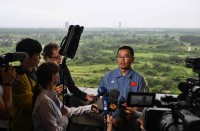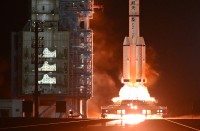Nassiriya Museum has reopened for the first time since its closure in 1991 after it was looted during a Shi’ite uprising in southern Iraq.
Built in 1969, the museum was pillaged and destroyed during the uprising, prompting the then government of Saddam Hussein to close the facility and move remaining artifacts to Baghdad.
Situated in the southern city of Nassiriya, the museum is the second largest in Iraq after Baghdad’s Iraq Museum.
It has more than 600 artifacts belonging to ancient periods dating back more than 7,000 years. The two-storey museum with 14 halls was renovated at a cost of one and a half billion Iraqi dinars ($1.29 million).
On the first floor, the halls showcased a wide range of figurines, seals and pots, while halls on the second floor were yet to be filled.
Archaeologist Amer Abdul Razzaq said his colleagues had put in a lot of work for the reopening.
“Thanks to the efforts of Iraqi archaeologists and their relentless around- the-clock work, around 600 pieces of artifacts have been restored and were distributed among the seven halls of the museum’s 1st floor according to the historic periods witnessed by Nassiriya city.”
The museum shows antiquities dating back to the pre-Islamic era, the ancient Sumerian period, the old and Neo Babylonian periods, the Assyrian period, Hatra ancient period and the Islamic period.
“These antiquities were at the Iraqi Museum in Baghdad. They were handed back to Nassiriya city and delivered to this museum after its opening. Following its closure, they (artifacts) were taken and kept in special boxes and they are restored now. Most of these pieces were unearthed from archaeological sites in Dhi Qar province, while others were found in different archaeological sites in north and south Iraq,” Abdul Razzaq said.
The site of ancient Mesopotamia and known by some as the birthplace of writing, agriculture and codified law, Iraq is steeped in history.
It boasts of 12,000 discovered historical sites, chief among them Babylon, 85 miles south of Baghdad, Nimrud in northern city of Mosul, the medieval Islamic city of Samarra and the ancient Sumerian city of Ur in Nassiriya province.
Iraq’s Minister of Tourism and Antiquities Adel Shirshab said the opening of the museum was a counter attack to the destruction of its ancient archaeological sites by the radical militants of the Islamic State.
“We have opened the Iraq Museum and today we’re opening Nassiriya Museum and in the coming few days we will open Muthanna museum, add to that efforts of excavation missions, which unearthed valuable antiquities in Tell Abu Tubera and Tell Khaiber. All these efforts are our response to an organized destructive act led by Daesh,” Shirshab told reporters at the opening ceremony of the museum, using the pejorative Arabic name for the Islamic State.
Iraq’s heritage already suffered a major blow in the lawlessness and looting that followed the toppling of President Saddam Hussein by U.S.-led forces in 2003, when looters torched buildings and ran off with treasures thousands of years old.
However, Islamic State militants attacked the 2,000-year-old city of Hatra in northern Iraq this month with bulldozers, officials say, days after assaulting the ancient Assyrian city of Nimrud.
Hatra dates back 2,000 years to the Seleucid, the empire which controlled a large part of the ancient world conquered by Alexander the Great. It is famous for its striking pillared temple which blends Graeco-Roman and eastern architecture.
Video showed the militants toppling statues in the Mosul museum and smashing them with sledge hammers and drills. It also showed damage to a huge statue of a bull at the Nergal Gate into the city of Nineveh.
A few days later Islamic State militants desecrated ancient razed parts of the 2,700-year-old city of Khorsabad famed for its colossal statues of human-headed winged bulls.
The group rejects all but its own narrow interpretation of early Sunni Muslim theology as heresy and has systematically destroyed historic temples, shrines, manuscripts statues and carvings. Officials say it has also looted widely, selling artifacts to help fund its rule.
Iraqi antiquities officials said in the northern province of Nineveh alone there were 1,700 archaeological sites under Islamic State control, as well as Iraq’s third largest museum at Mosul, ransacked by the insurgents according to video footage released on March 11.
Archaeologists have compared the assault on Iraq’s cultural history to the Taliban’s destruction of the Bamyan Buddhas in 2001.
(Reuters)







